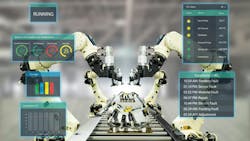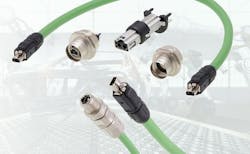Make the Move from Industrial Automation to the Smart Factory
What you’ll learn:
- The basics of industrial automation, smart factory, and Industry 4.0.
- The importance of power and connectivity in smart factories.
- The outcome of applying the lessons learned.
Automation does not a smart factory make. Though necessary to create a smart factory, automation isn’t sufficient. This distinction is important since a truly smart factory can dramatically improve your productivity, quality, and versatility.
Industrial automation is the control and monitoring of industrial machinery and processes with sensors, actuators, and control systems driven by computers. It’s safer and more efficient than hands-on human operation of machines, but is, by definition, repetitive.
A smart factory infuses automation with intelligence. Automated processes are thoroughly interconnected, integrated, and choreographed by a range of cutting-edge technologies. Processes adapt to changing conditions rather than simply repeating themselves.
The entire factory environment is “thinking” and “deciding” with the help of data-driven algorithms and artificial intelligence. Machines communicate with one another over distributed control systems and intelligent automation networks, rarely waiting for humans to tell them what to do.
>>Check out these TechXchanges for similar articles and videos
Smart factory ingredients include:
- The industrial Internet of Things (IIoT): Interconnecting industrial devices via the internet enables data collection, analysis, and control to enhance operational efficiency, productivity, and decision-making. In a smart factory, machines, sensors, and other connected devices communicate with one another, exchanging real-time data for predictive maintenance, maintaining asset health, and supply-chain visibility.
- Artificial intelligence (AI): AI and machine learning (ML) help machines recognize patterns, optimize processes, and perform predictive analytics.
- Digital twins: These interactive software models represent hardware environments and allow for simulations of alternative workflows, actions, and layouts to optimize performance.
- Robotics: In a smart factory, robots can work on an assembly line, collaborate with humans, or whiz autonomously around a factory floor and perform tasks like selecting components.
- Cloud computing: This on-demand infrastructure lets organizations focus on primary business competencies by providing on-demand access to a shared pool of computing resources, such as servers, storage, and applications over the internet. Users can consume resources as needed.
- Augmented reality (AR) and virtual reality (VR): AR technology overlays digital information, such as images, videos, or 3D models, onto the real world, while VR immerses users in a computer-generated simulated environment. AR and VR are used in training and maintenance, displaying schematics, fault codes, or maintenance logs directly in the technician’s field of view to facilitate diagnosing and fixing problems.
What About Connectivity in a Smart Factory?
Connectivity in a smart factory plays the crucial role of interconnecting automation system components of ever-increasing complexity. The most robust networking solution is industrial Ethernet (see figure). Unlike basic Ethernet in a typical business office, industrial Ethernet is designed to withstand harsh conditions, including extreme temperatures, humidity, electromagnetic interference, and physical stress in factories, power plants, and warehouses.
Industrial Ethernet is engineered for applications requiring precise timing and low latency where data-transmission times are predictable and consistent, e.g., robotic assembly lines, chemical processing, and packaging.
Consisting of four cable pairs to achieve multi-gigabit throughputs, industrial Ethernet is compatible with a wide range of industrial devices, including programmable logic controllers (PLCs), sensors, actuators, and human-machine interfaces (HMIs). For applications that don’t require multi-gigabit speeds, single-pair Ethernet (SPE) is a more compact, cost-effective solution.
Power Redundancy for Smart Factory Infrastructure
A smart factory requires much more computing than a conventional factory, including 24/7 availability of communication, control lines, and data centers. Therefore, operators must pay extra attention to reliable power. While data centers and critical computing units often have redundant backup systems, they still require power to carry out their functions after failover.
Power redundancy solutions include:
- Uninterruptible power supplies, which provide short-term power until backup generators come online.
- Dual power feeds, which, ideally, means the smart factory is connected to more than one grid and utility.
- Redundant distribution, including power lines and circuitry.
- Energy storage systems like batteries, which can release power during outages or peak demand.
- Smart monitoring with the ability to switch to redundant power sources before human operators detect a problem.
- A written disaster recovery plan and periodically testing power outage scenarios.
Bringing It All Together with Reliable Connections
Finally, for IoT-connected systems to operate a single entity, a smart factory requires reliable connections, and where there are connections, there are connectors. Durability and reliability are paramount to ensure they’re never the weakest link.
Component suppliers, such as Newark, offer a wide range of dependable connectors. These include easy-to-install factory-molded connectors with crush-resistant prewired cord sets for power distribution; DIN valve connectors for air tools in volume production like valve manufacturing; and I/O modules and sensor cables.
You can make your factory smart with intelligent applications, state-of-the-art equipment, and reliable power, all thoughtfully interconnected. Why just automate when your operation can outthink the competition?
>>Check out these TechXchanges for similar articles and videos
About the Author

Randall Scasny
Senior Community Content Specialist, Newark
Randall Scasny is a senior community content specialist for Avnet's element14 Community, an electronics industry community of thousands of engineers, industry experts, independent sources, makers, and STEM advocates from all over the world. For more information about the element14 community, visit https://community.element14.com.



